Page 3 - Why I returned the Sigma (twice)
Initial Impressions
After unpacking the Sigma lens and taking a few "real world" shots I was convinced I had chosen wisely. First impressions were of a very solidly made lens, with none of the wobble and "play" in the mechanisms I was used to from my old Canon 28-105 lens and was to discover again with the 17-85. On the camera, the bright f2.8 aperture made a visible difference to the viewfinder image, which almost sparkled. in fact it did sparkle - with certain subjects an odd sort of "moire" effect appeared when critical focus was achieved. Certainly a world away from the slightly fuzzy looking grainy dullness I was used to with that slower old Canon lens. I was pretty happy with myself for finding a lens with the same maximum aperture and a wider zoom range than the Canon 16-35 f2.8L for one third of the price and, equally importantly half of the weight of that lens.
 The
picture of the Tower of London, left, is typical of the bitingly sharp,
colourful images which I was seeing from the Sigma lens. The
extract below is at "actual pixels" resolution and shows the plaque
above the doorway on the right of the picture. Resolution looks to
be limited by the EOS20D's sensor rather than any fuzziness of the lens.
There is a hint of chromatic aberration visible in the "actual pixels"
crop but I doubt this would be visible on a print unless it was over A3
size, and even then it could be corrected.
The
picture of the Tower of London, left, is typical of the bitingly sharp,
colourful images which I was seeing from the Sigma lens. The
extract below is at "actual pixels" resolution and shows the plaque
above the doorway on the right of the picture. Resolution looks to
be limited by the EOS20D's sensor rather than any fuzziness of the lens.
There is a hint of chromatic aberration visible in the "actual pixels"
crop but I doubt this would be visible on a print unless it was over A3
size, and even then it could be corrected.
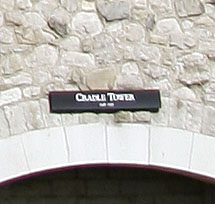
 This
shot of a sheep and new-born lamb was shot at 50mm, wide-open at f2.8.
I learned that 50mm is not a long enough focal length to get close to
new born lambs and their protective mothers (the shot had to be cropped
significantly). Despite the lens being wide open, the shot is sharp (see
"actual pixels" extract below).
This
shot of a sheep and new-born lamb was shot at 50mm, wide-open at f2.8.
I learned that 50mm is not a long enough focal length to get close to
new born lambs and their protective mothers (the shot had to be cropped
significantly). Despite the lens being wide open, the shot is sharp (see
"actual pixels" extract below).

Pros and Cons
Those are the "pros". Other "pros" are the inclusion of a lens hood and pouch in the box (Canon, stingily, charges extra for a lens hood and I'm not sure whether a pouch is even an option).
Build quality and handling
Ironically I'd say the Sigma feels better built than the Canon. There is no play whatsoever in the zoom and focus rings, whereas the Canon feels a bit rattly and wobbly by comparison (the Canon ratttles when you shake it where the sigma is tight and silent). The Canon is heavier (slightly) but seems to balance better on the EOS 20D. It is significantly wider and more of the weight in the glass seems to be towards the back of the lens. This is perhaps not surprising as this is an EF-S lens - all that glass at the back of the lens, poking out beyond the lens mount is what makes it only fit the EOS 20D, 300D and 350D with their smaller mirrors, whereas the Sigma will fit on the 10D, D60 and D30 too. The Sigma seems front heavy by comparison and makes the camera hang down in the same way it does with a long telephoto.
Focusing on the Canon lens seems much superior, although I strongly suspect a lot of this is perception - a psychological effect of the Canon USM system being silent whilst the Sigma is noisy. When focussing happens silently I think the brain is convinced it also happens quickly, whereas the sound the Sigma makes reminds me of my old Minolta 600si which used to take half an hour to lock focus. The Canon lens can be focussed manually without switching to MF mode. Ironically because the Canon focuses quickly and accurately anyway, and the viewfinder image is dull, I haven't felt the need to tweak focus manually whereas with the Sigma I switched to manual focus a few times and felt I could do better than the autofocus, so bright and crisp is the viewfinder when the Sigma is attached. So the lack of "full time manual focus" on the Sigma is a shame, especially as other "premium" Sigma lenses feature HSM, Sigma's version of USM.
Up against a Brick Wall
I had read reports on the internet of some Sigma lenses being defective, so I thought it was worth testing my new lens against the most revealing test target - a brick wall.

Sigma 18-50 @ f2.8
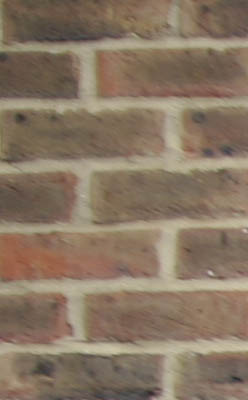
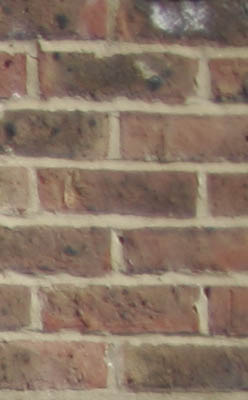
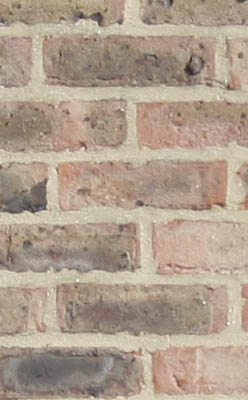
The three extracts above are "actual pixels" crops from the top left, centre, and top right of the brick wall photo, taken at f2.8. As expected the centre is sharpest, and there is some light fall-off towards the corners. More disturbing is that the left hand side is demonstrably less sharp than the right. This is reflected in the size of the Jpeg files; 25k for the centre, 20k for the right and only 17k for the left (jpeg sizes are a good indication of the level of detail in a file).
Sigma 18-50 @ f8
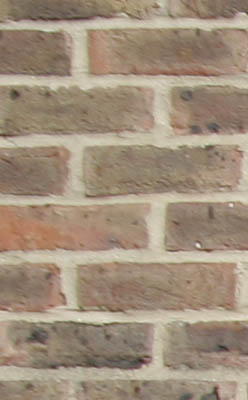
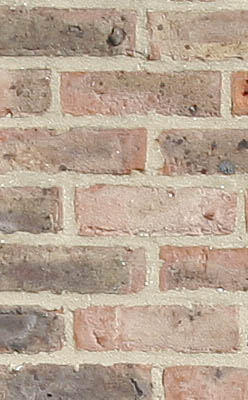
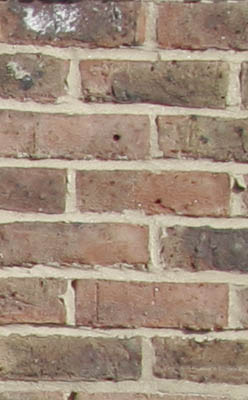
The extracts above are from the same shot re-taken at f8. The light fall-off is less, as would be expected, but the left hand of the frame is still remarkably soft. The difference between the soft left hand side and the acceptable right hand side is even more pronounced.
I returned the lens. The shop assistant told me other customers had done the same, and recommended I bring my camera into the shop to test a number of samples of the lens until I found a good one. I declined and took a replacement lens, hoping I had just been unlucky with the first lens. The new lens was a slight improvement, but still unacceptable, and still the same problem - at 18mm, about 1/4 of the image at the left hand side was unacceptably soft but this was not matched on the right hand side:

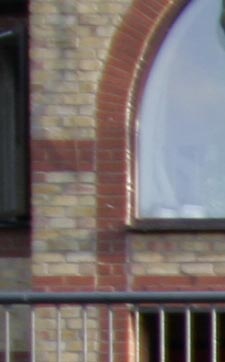
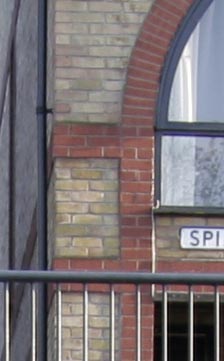
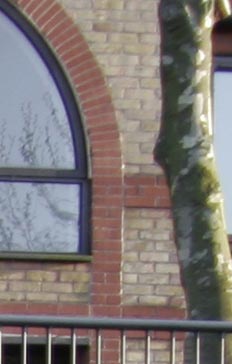
So I "upgraded" to the more expensive Canon lens.
Canon 17-85 IS @ f4
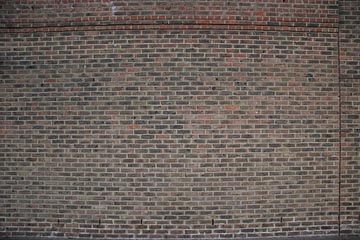
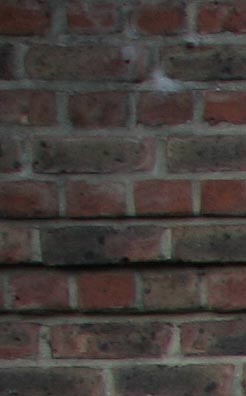
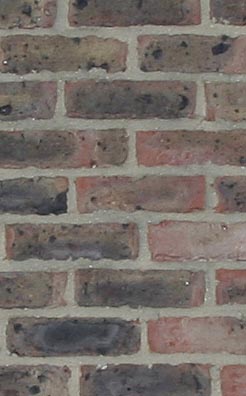
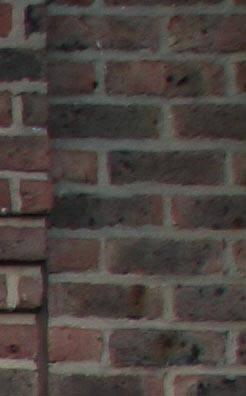
The extracts above are from a similar shot of the same wall taken with the Canon 17-85 IS at 17mm, wide open at f4. As the shots were taken on different days and particularly as it was much darker when I took the Canon test shot (ISO 200 was used compared to 100 for the Sigma shots), fair comparison with the Sigma is impossible. It is clear that the edges of the Canon frame are not as sharp as the centre and the light fall off is more noticeable with the Canon at f4 than with the Sigma at f2.8. However the loss of quality in the corners is consistent from left to right, which is reflected in the jpeg sizes (29 for the centre and 21 for both left and right). Whilst the Canon results are hardly inspiring, they're not as shocking as those from both Sigma lenses. And after all, even the first, worst, Sigma lens was impressive for "real world" shots. The Canon passes the torture test.
PTLens
In the digital age, distortion and vignetting are not the problems they once were, thanks to a truly remarkable Photoshop filter called PTLens.

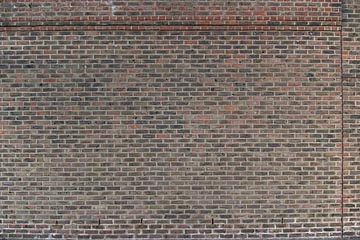
On the left is the wall image. On the right is the same image, after being passed through PTLens. PTLens corrects distortion and vignetting, as you can see. Here are the left, centre and right extracts:
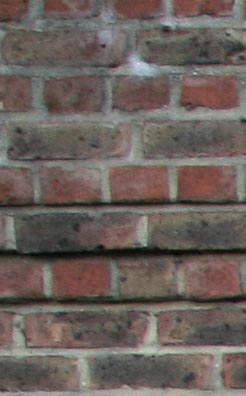
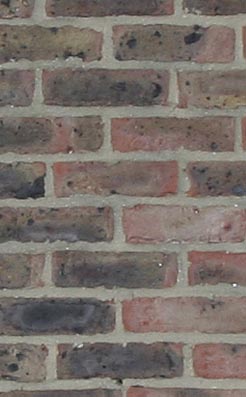
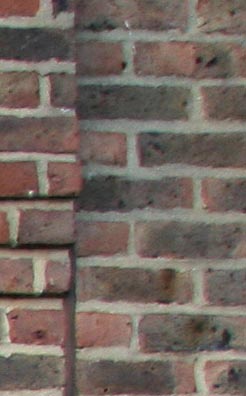
Not only does it work, but the user interface is superb and almost everything is taken care of automatically but with the ability to manually over-ride. Astoundingly, for something which I suspect most digital photographers would happily pay at least Ģ50 for, PTLens is free. There is absolutely no reason not to get it now from here.
Conclusions
I imagine the Canon 16-35 f2.8L lens would produce sharper wall shots. But it lacks IS, is big and heavy and costs more than twice as much as the 17-85. I suspect in my hands it wouldn't produce better real world shots. The Canon 17-40 f4L would also probably do sharper walls for a similar price to the 17-85 IS. But again, no IS and the shorter zoom range make it a much less flexible lens. For a reasonably sized, reasonably lightweight all purpose compromise, the EOS 20D with Canon 17-85IS is a great combination.
Other Sources
I did my research before buying the Sigma lens. The following reviews led me to believe the Sigma was the lens for me:
Topicpoint.com review of Sigma 18-50mm f2.8
Jasonlivingston.com review, comparing the Sigma (favourably) with Canon L series
Another review compares the Sigma to a Carl Zeiss prime, and concludes that the Sigma is "Highly Recommended". Note the following interesting quote:
One thing I noticed in my first test (18 mm and 50 mm) was, that not all four corners looked the same. One reason for this is most likely, that the camera wasnīt positioned 100% parallel to the target. Since the target is not that large (especially at 18 mm, I was quite close to the target), any small deviation could lead to such an effect. Also, if the lens elements arenīt centered 100% perfectly, this will lead to some difference between the outer corners. This effect was mainly noticeable wide open. The corner crops I posted for the Sigma lens are the ones which looked best.
(c) Philip Harle 30 April 2005